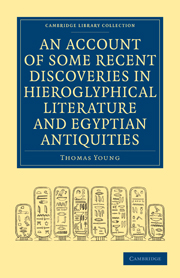 An Account of Some Recent Discoveries in Hieroglyphical Literature and Egyptian Antiquities
An Account of Some Recent Discoveries in Hieroglyphical Literature and Egyptian Antiquities Book contents
- Frontmatter
- Contents
- PREFACE
- WORKS OF THE AUTHOR
- CHAPTER I Introductory Sketch of the Prevalent Opinions respecting Hieroglyphics
- CHAPTER II Investigations founded on the Pillar of Rosetta
- CHAPTER III Additional Inferences, deduced from the Egyptian Manuscripts, and from other Monuments
- CHAPTER IV Collections of the French.—Mr. Drovetti.—Mr. Champollion's Discoveries
- CHAPTER V Illustrations of the Manuscripts brought from Egypt by Mr. Grey
- CHAPTER VI Extracts from Diodorus and Herodotus; relating to Mummies
- CHAPTER VII Extracts from Strabo; Alphabet of Champollion; Hieroglyphical and Enchorial Names
- CHAPTER VIII Chronological History of the Ptolemies, extracted from various Authors
- APPENDIX I Greek text of the Manuscripts and Registries
- APPENDIX II Specimens of Hieroglyphics
CHAPTER III - Additional Inferences, deduced from the Egyptian Manuscripts, and from other Monuments
Published online by Cambridge University Press: 01 March 2011
- Frontmatter
- Contents
- PREFACE
- WORKS OF THE AUTHOR
- CHAPTER I Introductory Sketch of the Prevalent Opinions respecting Hieroglyphics
- CHAPTER II Investigations founded on the Pillar of Rosetta
- CHAPTER III Additional Inferences, deduced from the Egyptian Manuscripts, and from other Monuments
- CHAPTER IV Collections of the French.—Mr. Drovetti.—Mr. Champollion's Discoveries
- CHAPTER V Illustrations of the Manuscripts brought from Egypt by Mr. Grey
- CHAPTER VI Extracts from Diodorus and Herodotus; relating to Mummies
- CHAPTER VII Extracts from Strabo; Alphabet of Champollion; Hieroglyphical and Enchorial Names
- CHAPTER VIII Chronological History of the Ptolemies, extracted from various Authors
- APPENDIX I Greek text of the Manuscripts and Registries
- APPENDIX II Specimens of Hieroglyphics
Summary
MY full conviction respecting the nature and origin of the enchorial character I expressed at the end of a collection of letters, inserted in the Museum Criticum, and published in 1815. It was not, however, till the next year, that I obtained the most complete evidence of the truth of my opinion: having been obligingly accommodated, by Mr. William Hamilton, with the use of his copy of the great Description de l'Egypte as far as it was then published, I proceeded to study its contents: and I discovered, at length, that several of the manuscripts on papyrus, which had been carefully published in that work, exhibited very frequently the same text in different forms, deviating more or less from the perfect resemblance of the objects intended to be delineated, till they became, in many cases, mere lines and curves, and dashes and flourishes; but still answering, character for character, to the hieroglyphical or hieratic writing of the same chapters, found in other manuscripts, and of which the identity was sufficiently indicated, besides this coincidence, by the similarity of the larger tablets, or pictural representations, at the head of each chapter or column, which are almost universally found on the margins of manuscripts of a mythological nature. And the enchorial inscription of the pillar of Rosetta resembled very accurately, in its general appearance, the most unpicturesque of these manuscripts.
- Type
- Chapter
- Information
- An Account of Some Recent Discoveries in Hieroglyphical Literature and Egyptian AntiquitiesIncluding the Author's Original Alphabet, as Extended by Mr. Champollion, with a Translation of Five Unpublished Greek and Egyptian Manuscripts, pp. 15 - 33Publisher: Cambridge University PressPrint publication year: 2010First published in: 1823


